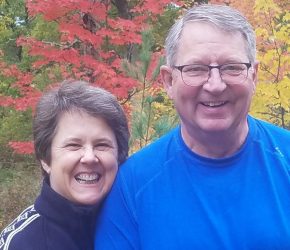
December 13, 2020; One In Christ; Pastor Rebecca Ellenson; Yellow Lake Lutheran Church
Today, at Yellow Lake Lutheran Church we are doing one more thing in a crazy pandemic way. We’re welcoming new members via the internet, “gathering” as a congregation virtually, and affirming our oneness in Christ through baptism even as we are isolated.
So much of what it means to be the church involves community, caring for each other, working together on service projects, singing in harmony, worshipping as a body by standing and sitting and responding with one voice. Our primary symbols of faith involve physical elements, water, bread, wine, fire. We don’t just believe doctrines we experience faith, in person. We need each other. Creation is interdependent. We are made to be social. What does it say in Genesis? It is not good for us to be alone.
It feels strange for me to preach through a camera to people I haven’t met, and I know it feels strange to tune in to church on the computer, to prepare your own elements for Holy Communion at home, and to speak the words of welcome to Keith and Karla, even though they can’t hear you. But these strange times compel us to find new ways to be the Body.
Last Sunday as I walked my dog, Mikko, I listened to an amazing episode of The Daily, a podcast from the New York Times. Its title was “The Social Life of Forests.” Scientist Suzanne Simard’s research has revolutionized the traditional understanding of trees. Instead of seeing the individual specimens of shrubs, plants, and trees as competing with each other for resources, crowding out other species, she discovered that the various trees in a forest are in fact connected and communicate through a subterranean network of fungi. The trees cooperate by sharing resources of soil nutrients and water, the strong and healthy supporting the weak and struggling individuals so that the whole forest thrives.
She used radioactive carbon to measure the flow and sharing of carbon between individual trees and across species and prove that birch and Douglas fir share carbon. Birch trees receive extra carbon from strong, well established Douglas firs that she sometimes calls Mother Trees because of their nurturing properties. Then when the birch trees lose their leaves, they supply carbon to the smaller, weaker Douglas fir trees that are in the shade. Evidently, it is not even good for trees to be alone.
In this year of separation, I’ve gained a new appreciation for Paul’s writings. He started many churches in his travels as a missionary, spreading the news about Jesus to non-Jews and broadening the reach of the gospel. Then he wrote letters to those baby churches that he had started, addressing the issues they faced in a personal and pastoral way. I can relate to his longing to be connected to the people he has been separated from. He longed to see people face to face again. We do too!
The lesson for today is from the first letter Paul wrote was to the church in Thessalonica. Chronologically speaking, 1st Thessalonians is the earliest part of the New Testament, written about 51 AD, just 18 years or so after Jesus’ death. The early church was in its infancy and was just figuring out how to form themselves, how to live as followers of Jesus, how to relate to and support one another.
In the book of Acts, we learn that Paul and Silas had preached in the Jewish synagogue there for only about 3 weeks. It must have been an intense time to generate such a strong response both from the new followers of Jesus Christ and from the establishment who fiercely opposed the missionary work they were doing. A riot occurred in the market. Paul was fled for safety to the home of a man named Jason, one of the believers. But Paul was dragged from there and brought before the Roman magistrates. Paul and Silas had to flee the city in the night.
The newly formed community needed encouragement. Paul was like a Mother Tree providing support to the new sapling congregation, commending them on their work, praying for them, and offering advice. He writes: (I’m reading this version from the paraphrase called The Message, by Eugene Peterson which expresses the text in current language.)
2-5 Every time we think of you, we thank God for you. Day and night you’re in our prayers as we call to mind your work of faith, your labor of love, and your patience of hope in following our Master, Jesus Christ, before God our Father. It is clear to us, friends, that God not only loves you very much but also has put his hand on you for something special. When the Message we preached came to you, it wasn’t just words. Something happened in you. The Holy Spirit put steel in your convictions.
5-6 You paid careful attention to the way we lived among you, and determined to live that way yourselves. In imitating us, you imitated the Master. Although great trouble accompanied the Word, you were able to take great joy from the Holy Spirit!—taking the trouble with the joy, the joy with the trouble.
7-10 Do you know that all over the provinces of both Macedonia and Achaia believers look up to you? The word has gotten around. Your lives are echoing the Master’s Word, not only in the provinces but all over the place. The news of your faith in God is out. We don’t even have to say anything anymore—you’re the message! People come up and tell us how you received us with open arms, how you deserted the dead idols of your old life so you could embrace and serve God, the true God. They marvel at how expectantly you await the arrival of his Son, whom he raised from the dead—Jesus, who rescued us from certain doom.
Paul applauds them for the way this newly sprouted group of believers was able to share its resources with others too. Paul sent Timothy to be with them and to continue teaching and leading them. The letter describes the tender care with which the ministry was undertaken, first by Paul and Silas, and then by Timothy. It is evident that there is a strong and loving relationship within the new Christian community there. There is also a great longing to be reunited and eager hope for the quick arrival of that time when they can be together again.
The model of the church we see in the New Testament times reveals an interdependence. In some cases, they pooled their resources, taking care of each other and living together or at least gathering each week for a meal to tell stories and share thoughts and prayers and concerns. Out of this weekly communal meal arose the tradition of Holy Communion.
These days, when we are refraining from gathering in person out of love and concern for each other, I have become intensely aware of how meaningful this communal aspect of faith is. Why is it that we are part of a church anyway? It’s not just hearing the Word. If it was as simple as learning the right doctrines then we wouldn’t need the church at all, we could get what we need in a class or a book. The social aspect of the faith is crucial.
Our reading for today is part of the closing chapter of Paul’s letter. He’s giving them specific advice about how to carry on. Evidently, they are tired of waiting for the return of Christ. Perhaps our context is similar right now. We’re longing for restoration too. We’re longing for community and a better day. He writes: (again this is from version called The Message.}
9-11 God didn’t set us up for an angry rejection but for salvation by our Master, Jesus Christ. He died for us, a death that triggered life. Whether we’re awake with the living or asleep with the dead, we’re alive with him! So speak encouraging words to one another. Build up hope so you’ll all be together in this, no one left out, no one left behind. I know you’re already doing this; just keep on doing it.
… He tells them to get along and do their part, be patient and when they get on each other’s nerves not to snap at each other. They should look for the best in each and rejoice and pray and thank God no matter what happens. And he tops it all off with this blessing:
23-24 May God himself, the God who makes everything holy and whole, make you holy and whole, put you together—spirit, soul, and body—and keep you fit for the coming of our Master, Jesus Christ. The One who called you is completely dependable. If he said it, he’ll do it!
At the time that Paul wrote, the followers of Jesus were both spreading over the whole known world and like trees in a forest they were united, not through a subterranean network of fungi, but through prayer, through sharing their resources with those in need, and through a joint purpose of following the example of Jesus Christ. Christian faith has always been about uniting people to become brothers and sisters in faith. The Greek word for church is ekklesia and it simply means gathering or assembly. The church gathers around a meal with one cup and one loaf, a chorus of voices that raises its praise and prayers out loud, a pooling of resources to meet common goals, a mutual support offered in hugs and handshakes, smiles and tears. Christian faith is not just about believing the right things. The experience of God’s love in Christ goes beyond knowing into doing and being and sharing.
Today we recited the basic tenets of our faith, affirming our baptism together with our new members. That’s one thing that unites us, our shared belief. But knowing isn’t enough.
The doing part of faith is harder now, with distance restrictions. It is a challenge to find ways of serving others now. It’s so much easier to care for others when we are able to see them and hug them on Sundays when we gather. Those of us who are able to help distribute food have the reinforcement of doing good, seeing and feeling what it means to support others, to share like the early church did from our bounty for those in need. We can write checks and send them to organizations that serve others, donate to Christmas for Kids, and to our own congregation to support the many ways we support others. The spirit of this season is about giving, loving, and serving. It’s more important than ever to write our own letters of encouragement now, to make phone calls of caring concern. Why not find a way to reach out on the phone, in writing, in prayer. Be the light that shines in someone else’s day!
What hasn’t changed in this pandemic is the being part of faith. We are the Body of Christ. We are members one of a another. We are the communion of saints. Even now, when we cannot gather in the same place for worship, or physically eat from one loaf we are one body, joined with past, present and future disciples of Christ. To use a modern image: we are the forest, interconnected by a web of faith and prayer and the God’s ever-flowing supply of love.
Let us pray. Knit us together, Lord, even in our isolation. Teach us to use these quiet days to reach out in love, to pray for one another, to find ways to connect, to serve, to be your Body. Amen.

